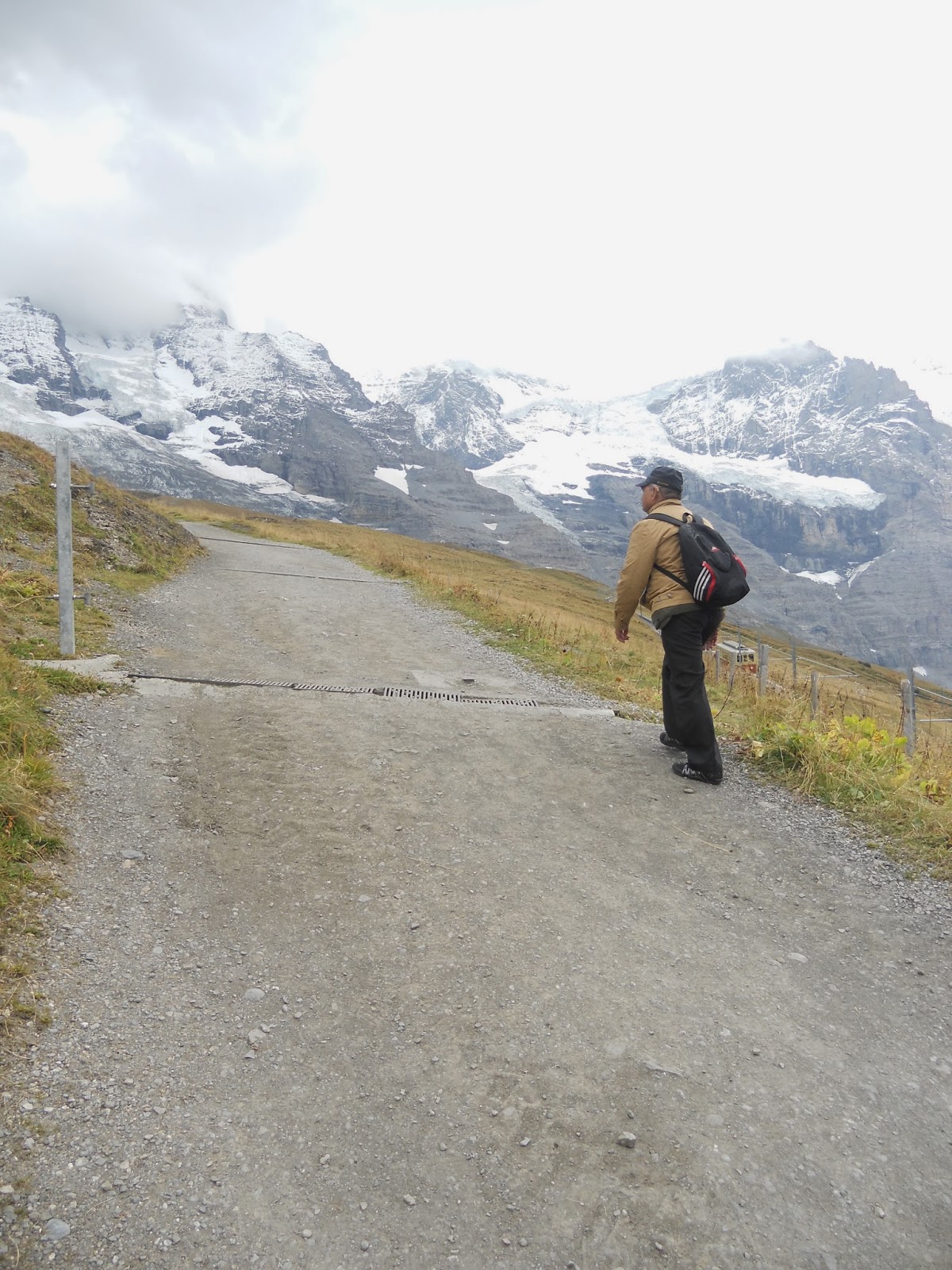
CHAPPIDI ABHIRATH REDDY,
C/O COL GKS REDDY,
Secunderabad - 500 015.
After the hectic tour of Wilderswil, Schynige Platte and Interlaken on 25 Sep 2013, we visited Jungfraujoch on 26 Sep 2013. The day was bright and sunny when we started from wilderswil, but unfortunately, by the time we reached Jungfraujoch Railway station, it started snowing heavily and the visibility outside Jungfraujoch was down to almost 5 yards, making it very difficult to see anything. Hence, we took a few snaps outside the Railway station, which were not very clear
Jungfraujoch
The Jungfraujoch is a col or saddle between the Mönch and the Jungfrau in the Bernese Alps on the boundary between the cantons of Bernand Valais, inside the Jungfrau-Aletsch Protected Area.
Strictly, the Jungfraujoch is the lowest point on the mountain ridge between Mönch and Jungfrau, at 3,466 meters (11,371 ft). Just east of this location, within the mountain, is the top station of the Jungfraubahn. The Jungfraujoch railway station, at an elevation of 3,454 meters (11,332 ft) is the highest railway station in Europe and is connected to the Top of Europe building.
We started from Wilderswil by Wengarnalp Bahn (Railway),
by 0730h for Rauterbrunnen Railway station, where we were
to change over to cog Railway to reach Jungfraujoch
At Lauterbrunnen Railway station, near the Cog Railway
View of a small Mountain Village between Lauterbrunnen
and Wengen Railway Stations
Another Larger Village just short of Wengen Station
Wengen Railwar Station at a height of 4180ft
A view of Jungfrau from Wengen
View of the landscape between Wengen and Eigerwand Stations
Eigerwand Railway Station enroute to Jungfraujoch
Eismeer Railway Station On way to Jungfraujoch
At Jungfraujoch Railway Station
Another view of Jungfraujoch Station
At the entrance of Jungfraujoch Station
Ice Cave at Jungfraujoch
After initial thrill of Ice Palace at Jungfraujoch, Switzerland, we had stopped for a moment watching a long corridor of ice that seemed no end in sight. While in the middle of the tunnel suddenly the chest tightens.
We then slowly went down the tunnel, a height of about 2 meters, with a floor of about 1.5 meters wide. A few minutes at the end of the hall space, ice looks like a rather large cave. On the walls there are a number of ice sculptures, ice sculptures of Sherlock Holmes, the detective character, animals, fish etc
The Tunnel / Corridor leading to the Ice Cave at Jungfraujoch
Near the Entrance of the Ice Cave
In the Ice Cave at Jungfraujoch
One of the Ice Sculptures in the cave
View of another Ice Sculpture in the Cave
Behind the Ice Counter in the Ice Cave
Outside Jungfraujoch Station
The Visibility outside was very poor, due to heavy snow fall. Hardly anything could be seen, still we took a few snaps, just near the entrance.
A snap outside the Railway Station
Another snap in the snow just outside the station
Bollywood Restaurant at Jungfraujoch Railway Station
Waiting for the downward journey at Jungfraujoch
On our way down we broke Journey at Klein Scheidegg Railway station to walk along the Eiger Walk, at a height of 7000 ft.
Eiger Trail
Those with the courage and the desire to get just that little bit closer to the breathtaking Eiger North Face and tackle a superlative high alpine adventure can take the Jungfrau Railway to the station at Eigergletscher and set out on the Eiger Trail. Shortly after starting on this route, you'll find yourself right in front of the famous rock face itself, and above you to the right you'll notice the metal ladders that climbers to the Eiger-Rotstock Via Ferrata use to gain access. From here on, the trail runs for an hour along the foot of the Eiger North Face, sparkling with a beautiful view over the Wetterhorn and the Grosse Scheidegg.
At the Klein Scheidegg Railway Station at a height of 7000 ft
Outside Kleine Scheidegg Railway Station
Near the Entrance of Eiger Trail
On the Eiger Walk
A short Break to catch some Breath on Eiger Walk
Slog on with Determination
Almost halfway through on Eiger Walk
A beautiful Mountain Lake Astride Eiger Walk
Icy waters of the Mountain Lake astride Eiger Walk
Another view of the beautiful Mountain Lake
Time to move on after the well earned break at the Mountain Lake
Route Markers along the Eiger Walk
A closeup of the Route Marker
My Daughter and Guide during Swiss Tour, Exuberant
on reaching the highest point on the walk
Note:- The information about the places visited has been Extracted from Wikipedia The Free Encyclopedia


























































.jpg)
















